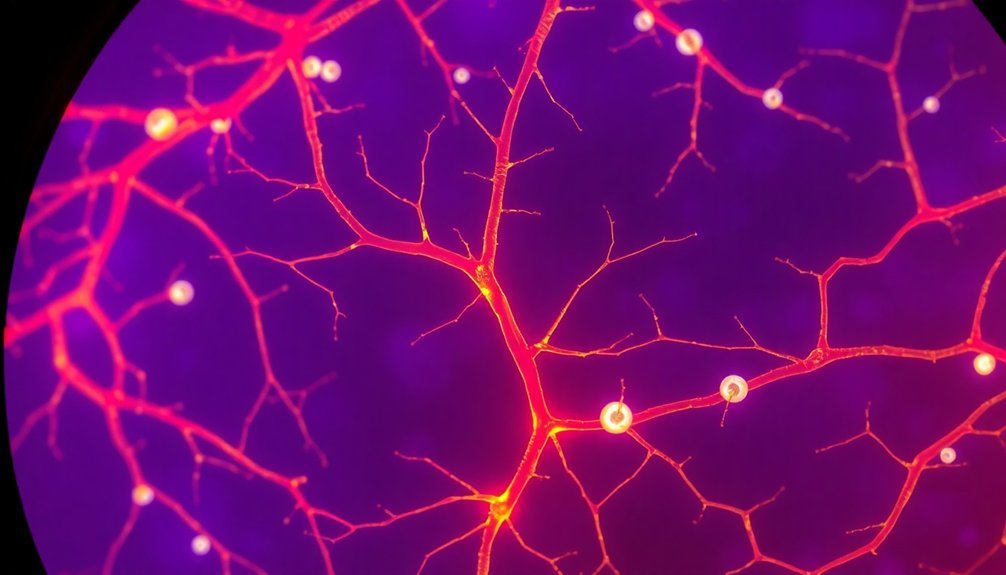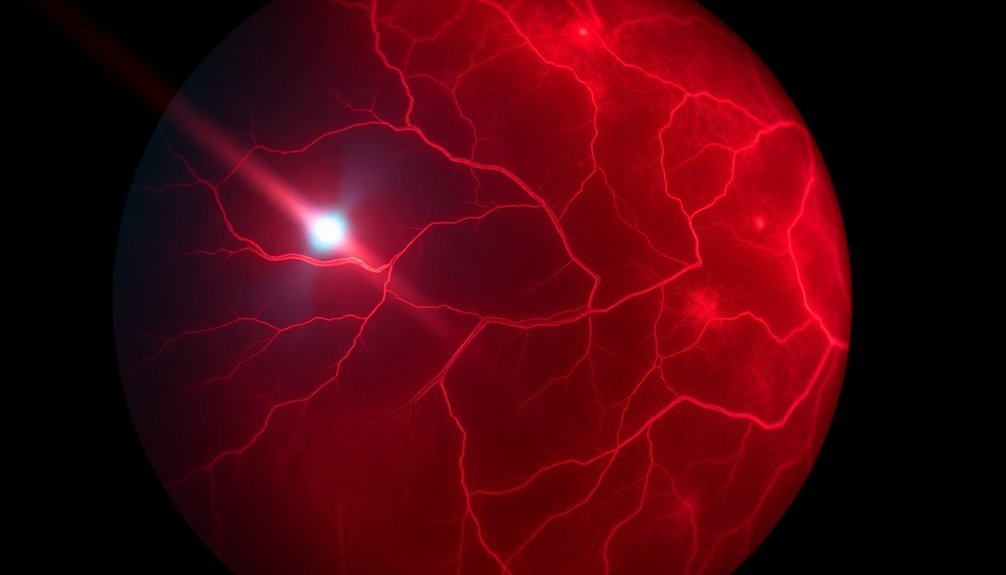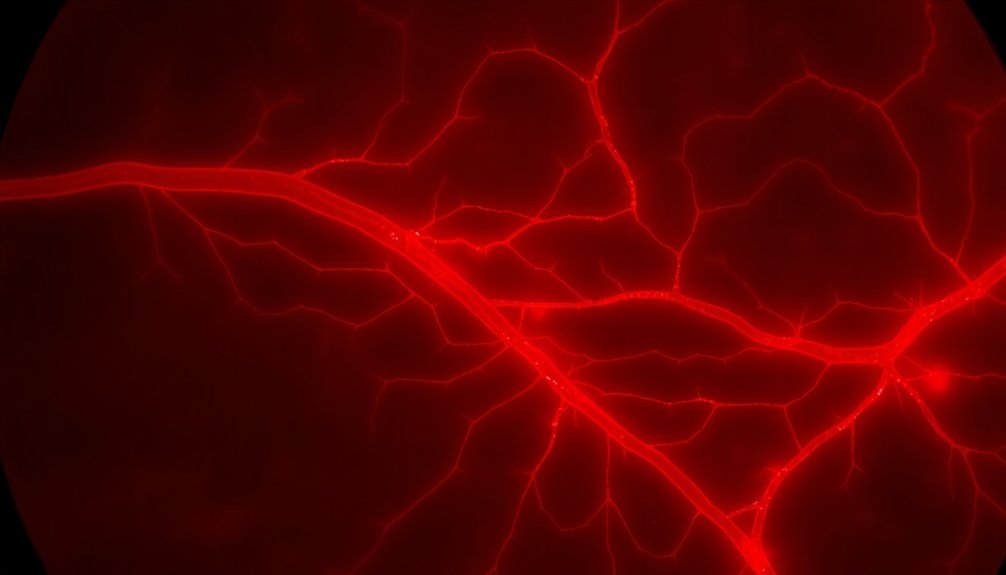Near-infrared light therapy improves your retinal blood flow by penetrating deep into eye tissue and triggering key biological responses. When the light hits your retinal cells, it activates cytochrome c oxidase in the mitochondria, boosting ATP energy production and releasing nitric oxide – a natural vasodilator that expands blood vessels. You'll experience enhanced circulation, reduced inflammation, and better oxygen delivery to retinal tissues. This increased blood flow helps manage oxidative stress and supports essential metabolic processes in your eye's photoreceptors and supporting cells. There's much more to discover about this revolutionary treatment's impact on vision health.
Understanding Near-Wavelength Light Therapy

Three key aspects define near-wavelength light therapy: its wavelength range, penetration depth, and therapeutic mechanisms. Near-infrared (NIR) light operates in the 700 to 1200 nm range, reaching depths of up to 5mm into your tissues, muscles, joints, and bones. This deep penetration enables effective treatment of various conditions through enhanced cellular activity.
NIR therapy works primarily by stimulating your mitochondria, boosting ATP production and cellular energy transport. When you undergo NIR treatment, you're benefiting from improved circulation, reduced inflammation, and accelerated healing processes. NIR therapy also promotes the release of nitric oxide production, which is essential for overall cellular health and function.
The therapy's effectiveness stems from its ability to penetrate deep tissues, where it can influence both cellular metabolism and systemic functions.
Different wavelengths within the NIR spectrum offer specific benefits. For instance, wavelengths like 810 nm and 850 nm are particularly effective for deep tissue treatment, while others around 940 nm provide specialized therapeutic effects.
You're not just getting surface-level treatment; you're receiving therapy that impacts your entire cellular system, promoting everything from enhanced blood flow to improved cellular regeneration and reduced inflammation.
Retinal Blood Flow Basics
Retinal blood flow stands out as a complex physiological system that hinges on multiple regulatory mechanisms working in concert. Your retina's ability to maintain proper blood flow relies heavily on autoregulation, which maintains consistent nutrient delivery regardless of changes in pressure or metabolic demands.
Through myogenic and metabolic mechanisms, your blood vessels actively respond to tissue needs by releasing specific vasoactive substances. The process is particularly evident when flicker stimulation occurs, causing increased blood flow to meet heightened retinal metabolic demands.
You'll find that retinal blood flow regulation involves several key components that work together to maintain proper function:
- Local factors, including nitric oxide and prostaglandins, play a dominant role in controlling blood flow, while your sympathetic nervous system has minimal influence.
- Oxygen and carbon dioxide levels directly impact flow rates – when oxygen decreases, blood flow increases, and higher CO2 leads to vessel dilation.
- Pressure autoregulation maintains steady flow despite varying perfusion pressures, adapting through multiple mechanisms affecting vascular tone.
- Endothelial-mediated responses, triggered by substances like ATP and nitric oxide, help fine-tune blood flow to match your retina's specific needs.
Understanding these basics helps explain why disrupted blood flow often accompanies various retinal diseases and conditions.
Cellular Energy Production

Energy production in retinal cells operates through a sophisticated network of metabolic pathways and cellular interactions. Your retina's cells work together through specialized transport systems, with GLUT1 and GLUT3 transporters managing glucose uptake in RPE cells and photoreceptors, respectively.
The retina has the highest energy demand of any neuronal tissue in the body. The astrocyte-neuron lactate shuttle then helps transfer energy between different cell types.
Photoreceptors are particularly demanding consumers of energy, requiring constant support from RPE and Müller glial cells for their continuous outer segment renewal. These cells rely on both glycolysis and oxidative phosphorylation, with pyruvate kinase enzymes playing essential roles in converting glucose to pyruvate.
Through the complex interplay of various metabolic cycles – including the Krebs, mini-Krebs, Cahill, and Cori cycles – your retinal cells maintain their energy needs.
Near-infrared light therapy enhances this energy production system by targeting Cytochrome C Oxidase (CCO) in the 600-1100 nm range. When you're exposed to specific wavelengths like 630 nm, 660 nm, or 980 nm, CCO activity increases, boosting ATP production and supporting overall retinal cell function.
Inflammation Control Methods
Your body's inflammatory response in the retina requires careful management through multiple control mechanisms. When retinal blood vessels become stiff or damaged, particularly in conditions like diabetes, they trigger inflammatory pathways that can lead to vision problems. Treatment with BAPN oral medication has shown promising results in preventing diabetes-related inflammation of retinal blood vessels.
Multi-wavelength LED therapy has emerged as an effective tool for controlling these inflammatory responses while protecting crucial retinal cells.
Key inflammation control methods that you'll benefit from include:
- LED irradiation therapy, which directly reduces pro-inflammatory cytokines and provides protection to corneal epithelial cells
- Nitric oxide modulation, which helps regulate blood flow and manage inflammation in conditions like glaucoma
- Autophagy enhancement in retinal pigment epithelial cells, reducing inflammation and improving cellular metabolism
- LOX inhibition, which prevents diabetes-induced inflammation by reducing capillary stiffness
These control methods work together with your body's natural autoregulatory mechanisms to maintain healthy retinal blood flow. By targeting specific inflammatory pathways, such as the complement cascade and RIPK-mediated necroptosis, these interventions can effectively manage chronic inflammation and protect your retinal tissue from damage.
The combination of these approaches helps preserve your vision by maintaining proper blood flow and reducing inflammatory stress.
Oxidative Stress Reduction

While managing inflammation is essential for retinal health, oxidative stress poses an equally substantial challenge to maintaining healthy blood vessels in your eyes. When your retinal cells experience excessive reactive oxygen species (ROS), they're at risk for vascular dysfunction and neurodegeneration. You'll find that NOX enzymes contribute markedly to this oxidative damage.
| Oxidative Stress Factor | Near-Wavelength Light Solution |
|---|---|
| Excessive ROS Formation | 670-nm light reduces oxidative stress |
| NOX Enzyme Activity | Light therapy decreases NOX damage |
| Mitochondrial Dysfunction | Improved mitochondrial potential |
| Vascular Damage | Enhanced blood flow and healing |
| Cellular Inflammation | Increased antioxidant production |
You'll benefit from near-wavelength therapy's ability to target oxidative stress through multiple pathways. When 670-nm light penetrates your retinal tissue, it activates cytochrome c oxidase, boosting your mitochondrial function and reducing oxidative damage. This therapy's particularly effective because it strengthens your cells' natural antioxidant defenses while improving blood flow to affected areas. Clinical studies show that this approach isn't just theoretical – patients with retinal vascular diseases have experienced measurable improvements in their condition through consistent near-wavelength light treatment.
Therapeutic Wavelength Ranges
Understanding therapeutic wavelength ranges requires careful consideration of their distinct effects on retinal blood flow and tissue health. When you're looking at effective treatments, you'll find two primary ranges that offer significant benefits: 600-700 nm (red light) and 700-1100 nm (near-infrared).
The red light range shows remarkable potential for enhancing mitochondrial function and ATP production, while near-infrared wavelengths excel at reducing inflammation and promoting healing in retinal tissues. You'll want to focus on specific wavelengths that have demonstrated the strongest therapeutic effects.
- 670 nm light effectively reduces diabetic macular edema and improves foveal thickness
- 810 nm near-infrared light enhances mitochondrial function in retinal neurons
- 660 nm light reduces drusen volume in atrophic AMD patients
- 850 nm light decreases inflammation while promoting tissue healing
You'll need to be cautious, though, as wavelengths below 600 nm can harm your retina, particularly if you have rod-cone dystrophy.
The key to successful treatment lies in selecting the precise wavelength for your specific condition, as validated by laser speckle flowmetry and confocal microscopy studies.
Clinical Treatment Applications

Clinical applications of near-wavelength therapy have demonstrated remarkable success in treating various retinal conditions, particularly age-related macular degeneration and diabetic macular edema.
When you undergo near-wavelength therapy, you'll benefit from increased retinal blood flow, which is essential for delivering oxygen and nutrients to your retina. This enhancement helps reduce light-induced stress and inflammation, addressing key factors in macular degeneration's progression.
The therapy's effectiveness stems from its ability to activate cytochrome c oxidase, which boosts mitochondrial energy metabolism and reduces harmful reactive oxygen species.
Exposure to red light at 670 nm wavelength substantially enhances your visual function, improving both best-corrected visual acuity and contrast sensitivity.
You can safely combine this treatment with other therapies, as it's proven to be both safe and effective without notable side effects. The benefits you'll experience aren't just temporary – they're sustained through repeated therapy sessions over time.
Additionally, the treatment's ability to suppress inflammation and promote photoreceptor survival makes it a valuable option for managing various retinal diseases, with improvements that can be quantitatively measured through reduced central macular thickness.
Mitochondrial Function Enhancement
Near-infrared light therapy triggers a remarkable boost in ATP production within your retinal cells' mitochondria, directly enhancing their energy-generating capacity.
You'll experience improved cellular energy balance as the treatment optimizes mitochondrial function and increases the availability of ATP for essential cellular processes.
This enhanced mitochondrial performance leads to better retinal cell survival and function, supporting your overall ocular health through improved energy metabolism.
ATP Production Boost
Light-powered cellular energy enhancement stands at the core of near-wavelength therapy's effectiveness in treating retinal blood flow issues. When near-infrared (NIR) light penetrates your retinal tissue, it triggers a remarkable boost in ATP production through enhanced mitochondrial function. This process occurs when photons in the 620-1150 nm range interact with cytochrome oxidase in your cells' mitochondria.
Your retinal cells experience these key benefits from NIR therapy:
- Increased cytochrome oxidase activity, leading to higher oxygen consumption and ATP generation
- Enhanced mitochondrial membrane potential, improving overall energy metabolism
- Greater oxidative phosphorylation efficiency, resulting in more ATP production
- Reduced oxidative stress, protecting retinal blood vessels
This ATP boost is particularly essential for your retinal pigment epithelium (RPE), which is highly susceptible to mitochondrial dysfunction in conditions like age-related macular degeneration.
Cellular Energy Balance
Maintaining ideal cellular energy balance in your retinal cells depends critically on enhanced mitochondrial function. When your mitochondria work at their best, they'll efficiently produce energy through oxidative phosphorylation, particularly in the inner segments of your photoreceptors where energy demands are highest.
Near-wavelength therapy directly influences this balance by stimulating your mitochondrial respiration. When near-infrared light hits your retinal cells, it donates photons that cytochrome oxidase absorbs, triggering increased energy metabolism. This boost helps your retinal pigment epithelium (RPE) cells better manage their dual role of glucose shuttling and metabolite processing.
You'll experience improved cellular energy balance through several mechanisms. Your cells will maintain steadier ATP production, handle oxidative stress more effectively, and sustain the high metabolic demands of phototransduction.
This enhancement becomes especially important because your retinal cells naturally face intense metabolic pressure. Clinical studies show that when your mitochondrial function improves through near-wavelength therapy, you'll likely see better retinal blood flow and reduced risk of age-related macular degeneration. Your cells can then maintain their energy requirements while protecting against potential damage from metabolic stress.
Photoreceptor Response Mechanisms

The retina's photoreceptor cells execute a remarkable cascade of molecular events when responding to light stimulation. When light hits these specialized cells, photopigments like rhodopsin absorb photons, triggering a complex signal transduction pathway that leads to cellular hyperpolarization through the closure of sodium channels.
Photoreceptor responses vary between vertebrates and invertebrates, with each showing distinct cellular reactions to light exposure. In vertebrates like humans, you're looking at a hyperpolarization response, while invertebrates typically show depolarization.
- Light absorption activates a G-protein called transducin, which then triggers phosphodiesterase to break down cGMP into 5'GMP
- The reduction in cGMP causes sodium channels to close, leading to cellular hyperpolarization
- Near-infrared light therapy enhances this process by stimulating cytochrome c oxidase in mitochondria
- This stimulation increases ATP production and improves cellular energy metabolism.
Understanding these mechanisms helps explain why near-wavelength therapy effectively improves retinal blood flow. The therapy works through cytochrome c oxidase, which serves as a primary photoreceptor for red and near-infrared light, ultimately enhancing mitochondrial function and cellular energy production.
Retinal Disease Prevention
Prevention of retinal diseases requires a thorough understanding of both risk factors and emerging therapeutic approaches. You'll find that near-infrared light therapy, particularly photobiomodulation (PBM), offers promising preventive benefits for various retinal conditions. While you can't reverse conditions like retinal vein occlusion once they occur, you can take steps to prevent complications and protect your retinal health.
| Condition | Risk Factors | PBM Benefits |
|---|---|---|
| AMD | Age, genetics | Improves visual acuity |
| Diabetic Retinopathy | Diabetes, hypertension | Reduces inflammation |
| RVO | High blood pressure | Enhances blood flow |
If you're over 50 or have risk factors like diabetes or high blood pressure, you'll want to reflect on PBM's preventive potential. The therapy works by activating cytochrome c oxidase, which triggers beneficial metabolic and antioxidant effects. You'll benefit from PBM's ability to protect photoreceptors and reduce inflammation before serious damage occurs. Clinical studies show that regular PBM treatments can improve contrast sensitivity and visual acuity while reducing structural damage. The therapy's non-invasive nature and lack of adverse effects make it an attractive preventive option for maintaining retinal health.
Treatment Duration and Intensity

Successful near-wavelength therapy depends heavily on carefully calibrated treatment durations and light intensities. When you're undergoing this treatment, both the length of exposure and the power of the near-infrared (NIR) light must be precisely controlled to achieve the best results.
The shift between light and dark states can increase retinal blood flow by 40-70%, making proper timing essential.
The intensity of NIR light follows a biphasic dose response, meaning there's a sweet spot for therapeutic benefits. You'll want to work with your healthcare provider to find the right balance, as intensities that are too high or too low can be ineffective or even harmful.
Here are four key factors that influence treatment success:
- Duration of light exposure directly affects blood flow changes
- Light intensity should mirror natural sunlight levels for the best response
- Treatment frequency must align with your specific retinal condition
- Individual responses require personalized protocol adjustments
Long-Term Vision Benefits
Promising research demonstrates that near-wavelength therapy delivers substantial long-term benefits for your vision health. A five-year study of patients averaging 67 years old revealed significant improvements in visual acuity, particularly in reading distant letters and numbers, with no adverse effects reported.
You'll find that this therapy effectively reduces edema and hemorrhaging in your eyes, leading to clearer vision and fewer broken blood vessels.
It's particularly beneficial if you're at risk for glaucoma or age-related macular degeneration, as it helps protect your cornea and retina against harmful ocular pressure and fluid buildup.
Your retina responds particularly well to red light wavelengths, showing better resistance compared to shorter wavelengths like blue light. The therapy increases your mitochondrial membrane potential while decreasing retinal inflammation.
If you're concerned about retinal degeneration, you'll be encouraged to know that this treatment can improve retinal healing and protect your photoreceptor cells from damage.
Research confirms that short, repeated sessions are more effective than constant long-term exposure, making this a practical treatment option for maintaining your long-term vision health.
Frequently Asked Questions
Can Near-Wavelength Therapy Be Combined With Traditional Eye Medications?
Yes, you can combine near-wavelength therapy with traditional eye medications. It's shown to create synergistic effects, enhancing treatment outcomes. Just make certain your doctor oversees the combination to monitor safety and optimize dosing.
How Does Eye Color Affect the Effectiveness of Near-Wavelength Therapy?
Your eye color doesn't affect near-wavelength therapy's effectiveness. The treatment works at the cellular level through mitochondrial function and blood flow regulation, regardless of your iris pigmentation. You'll get similar therapeutic benefits.
Are There Specific Foods That Enhance the Benefits of Near-Wavelength Therapy?
You'll enhance near-wavelength therapy benefits by eating colorful fruits, leafy greens, fatty fish, nuts, and legumes. These foods provide essential antioxidants, omega-3s, and vitamins A and C for superior results.
Does Wearing Contact Lenses Impact the Effectiveness of Near-Wavelength Treatments?
Yes, your contact lenses can affect near-wavelength treatments. While soft lenses may interfere with light penetration, the exact impact isn't fully understood. It's best to consult your eye doctor before starting treatment.
Can Near-Wavelength Therapy Help With Night Vision or Color Perception Problems?
Yes, you'll likely see improvements in both areas. Near-wavelength therapy can enhance your night vision and color perception by stimulating retinal mitochondria. Studies show it's particularly effective for age-related vision decline.
In Summary
You'll find near-wavelength therapy substantially boosts your retinal blood flow through multiple mechanisms. Your cells produce more ATP, inflammation decreases, and oxidative stress drops when exposed to specific light wavelengths. By following recommended treatment durations, you're protecting your retinal health and potentially preventing serious eye conditions. Regular sessions will improve your overall vision health and maintain proper blood circulation in your eyes.





Leave a Reply